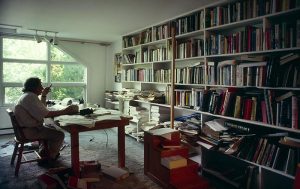After Looking at Mordecai Richler’s Library
What was lost when Mordecai Richler’s library moved from Lake Magog to LB 655 and 677 in the English Department at Concordia University? This essay contends that the “Richler Library” should not be seen as a collection that was simply looking for a warm and happy home and found it. Any writer’s library is not, as Richard Oram presents in his Handbook on the topic, “a set of books or other printed works owned by the author at a particular time” (1-2). A library is not “all the books and stuff” but a far-reaching assemblage and socially realized space that cannot be packed up, moved, cleaned up, and reordered without undergoing a sea change.
It is an open question if the assemblage and the space it produces can survive this change, no matter curatorial resuscitation efforts. It is another question if the intensely personal assemblage of a writer’s library can survive the death of its author, himself or herself not just its creator and caretaker, but one of its critical components.
The new order of Mordecai Richler’s private library is arbitrary. Its meticulous touch only emphasizes this. The collection’s objects have been classified, duly separated, and stored apart in two rooms and a hallway. Miscellany have been locked away in white cupboards. A salient system of organization is at work, which could have been another system. For the books, it is the system of classification of the Library of Congress. One slip of paper or more sticks out of each book, announcing that it is documented: it has its papers and can pass into this new world and exist on the new terms of production. Without its papers, it would be lost here. It would be an illegal in perceived need of legalization, or else. These slips visually chop up the collection—they catch the eye and create a visual stutter—a constant reminder that the laws of this library are one of its most active dimensions, and they are not the old laws.
A library’s organization is part of its constitution. This aspect of the old assemblage is lost. This is no minor loss, though it is convenient to ignore it. In Collecting, Curating, and Researching Writers’ Libraries: A Handbook, Richard Oram glosses over the question of how writers’ libraries are organized, saying, “I have never known a scholar to be very interested in it” (23). This is a big problem—a dead spot—in the study of these libraries. If the organization cannot be preserved, its absence should be well-noted and weighed in. It should haunt us. If the organization is somehow preserved, its impenetrability is another question.
What else is lost? If this were a garden, imagine all the plants are plucked up and put in the back of a truck. A new gardener comes, moves the plants and some of the rocks to another yard, then replants, prunes and spruces things up. Only desirable weeds make the cut. Is it the same garden? Not only has its original ordering logic, which includes its original chaos, been bowled over, but so has the composition of the garden. The composition of the library is lost, too. Its image is gone. In “Unpacking My Library,” Walter Benjamin emphasizes the importance of a library’s composition, describing “a relationship to objects which does not emphasize their functional, utilitarian value—that is, their usefulness—but studies and loves them as the scene, the stage, of their fate” (60). It is not romantic to believe the composition—“the scene,” “the stage”—matters. It is romantic to believe that it does not and that somehow the library survives its loss.
The assemblage is limping before we examine its greatest loss: the gardener-writer himself. As Benjamin describes, the author is not just the owner but a part of the library. Not only does the author shape his collection, but his memories are housed there; the library presents these memories in turn, in repetition with revision, shaping the author.
Benjamin goes so far as to equate himself with his collection. He does so grammatically with an elegant comma. He writes, “the most important fate of a copy is its encounter with him, with his own collection” (61). “Him” = “his own collection.” At the conclusion of “Unpacking My Library,” Benjamin plays out a dramatic trick—he pulls a trapdoor—emphasizing this symbiosis. In the final line, he abruptly exits, subsumed in the library he has just finished unpacking: “now he is going to disappear inside, as is only fitting” (67).
For Benjamin, the writer’s library is irrevocably personal. “For what else is this collection,” he writes, as he sorts through his books, “but a disorder to which habit has accommodated itself to such an extent that it can appear as order? You have all heard of people whom the loss of their books has turned into invalids, or of those who in order to acquire them became criminals” (60). Part of the library as assemblage is a highly individual “disorder to which habit has accommodated,” likely impossible for anyone else to follow and accommodate. This part of the library is within the author, and is so integral a part of him that Benjamin leaps to suggest that the loss of his books would be life-altering. Their loss could render one an invalid. And vice versa: the loss of the author in this situation would alter the library, which would never do the same kind of work and be the same space again.
There is a surprising and tender moment in Hannah Arendt’s “Introduction” to Benjamin’s Illuminations, in which she suggests that Benjamin, in fact, could not live without his library. Before describing the terrifying circumstances of his suicide on September 26, 1940, on the Franco-Spanish border—how the Spanish had closed the border that same day, blocking his already arduous route of escape—Arendt offers another reason for his death:
There were various reasons for this. The Gestapo had confiscated his Paris apartment, which contained his library (he had been able to get “the more important half” out of Germany) and many of his manuscripts, and he had reason to be concerned also about the others which, through the good offices of George Bataille, had been placed in the Bibliotèque Nationale prior to his flight from Paris to Lourdes, in unoccupied France. How was he to live without a library, how could he earn a living without the extensive collection of quotations and excerpts among his manuscripts?” (17-18)
“How was he to live without a library?” It is a question to honor, and one that circles back to ask: What is a writer’s library?
In The System of Objects, Jean Baudrillard provides another explanation for understanding the writer’s library as lifeblood.
What man gets from objects is not a guarantee of life after death but the possibility, from the present moment onwards, of continually experiencing the unfolding of his existence in a controlled, cyclical mode, symbolically transcending a real existence the irreversibility of whose progression he is powerless to affect…
Objects allow us to apply the work of mourning to ourselves right now, in everyday life, and this in turn allows us to live—to live regressively, no doubt, but at least to live. A person who collects is dead, but he literally survives himself through his collection, which (even while he lives) duplicates him infinitely, beyond death, by integrating death itself into the series, into the cycle. (104)
This theory is in harmony with Benjamin’s description of unpacking his library. Each book “duplicates him infinitely, beyond death,” in series. It is a cycle that stops with either the loss of the library or the loss of the author.
Benjamin’s ancestor here is Michel de Montaigne, who like Benjamin was at one with his library—his arrière boutique, to which he withdrew from court life to live among his books. De Montaigne saw his work as philosophy, defined in the title of one of his essays: “To Philosophize Is to Learn How to Die.” De Montaigne is like a DJ, sorting through his books and pulling samples to incorporate in his writing. His writing, his life, is a dance with his books. He keeps Baudrillard’s regressive but sustaining cycle going: “integrating death itself into the series.” In someone else’s hands, the cycle would not be the same; and without the cycle, the writer who now depends on it for his existence would be at a loss. Using Baudrillard’s terms, through their libraries Michel De Montaigne and Walter Benjamin “recite themselves, as it were, outside time” (103). They both claim to be writing about themselves (De Montaigne always, and Benjamin at the opening of “Unpacking My Library” is “speaking only about himself”). In talking about their libraries, they are talking about themselves: it’s equivalent. There is no de Montaigne apart from his library. For Benjamin, it’s the same.
In Oram’s Handbook to collecting writers’ libraries, he expresses surprise that the five writers interviewed for the book do not imagine their libraries surviving them. “More unexpectedly, most of the writers see their libraries as ephemeral and are reconciled to their eventual dispersal” (85). It seems like Oram is not listening to these writers, even though he pulled them into the conversation. If their libraries are “essentially ephemeral,” then they are “in essence” not something that can be preserved, like the writers themselves. What remains after a writer’s death is not his or her library, but a collection of archival materials.
To ground this argument, I am using Henri Lefebvre’s theory of space as socially produced. This way, we can see moving a writer’s library from his house to an institution as moving it from the terms of production of the house to the terms of production of the institution. Each space is different: “Each is produced—and serves a purpose” (403). The writer’s library is a produced space that is beyond replication.
Works Cited
Baudrillard, Jean. The System of Objects. London: Verso, 2005; 1996.
Benjamin, Walter, and Hannah Arendt. Illuminations. New York: Schocken Books, 2007; 1969.
De Montaigne, Michel. The Complete Works :Essays, Travel Journal, Letters. New York: A.A. Knopf, 2003.
Lefebvre, Henri. The Production of Space. Cambridge: Blackwell, 1991.
Oram, Richard W., and Joseph Nicholson, eds. Collecting, Curating, and Researching Writers’ Libraries: A Handbook. Landham, Maryland: Rowman & Littlefield, 2014.


